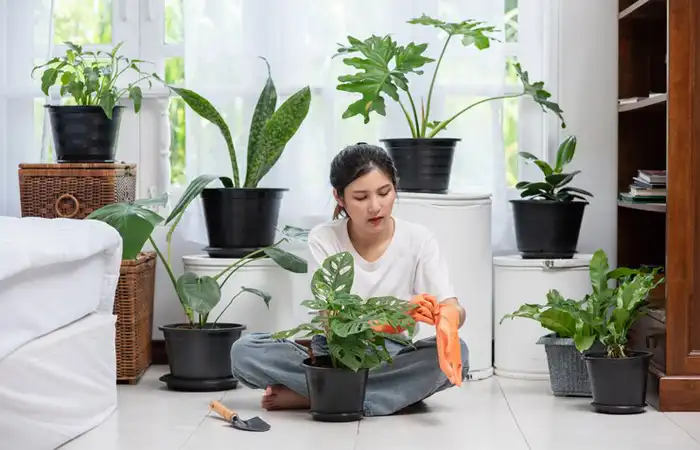
Blog
The Complete Guide to Houseplants in Any Room

Indoor plants infuse every environment with vitality, color, and a breath of fresh air, making them more than simply ornamental accents. This comprehensive guide will assist you in selecting the ideal indoor plants for each area in your home, regardless of your level of experience with gardening..
Living Room Bold Greenery.
Fig with fiddle leaves Ficus lyrata
The Fiddle Leaf Fig is a popular option for living rooms because of its striking appearance and huge, glossy leaves. It needs regular watering and does best in bright, indirect light. To maintain the finest possible appearance, dust the leaves on a regular basis.
Sansevieria trifasciata, or snake plant
The Snake Plant, which is renowned for its resilient character and attractive architecture, is ideal for giving your living area a contemporary feel. It is a great option for novices as it can withstand low light levels and infrequent watering.
Bedroom Air purifying and soothing plants.
lavandula, or lavender
Lavender offers relaxing qualities that can enhance the quality of your sleep in addition to adding a splash of color and aroma to your bedroom. Give it little waterings and place it in a sunny position.
Pathiphyllum, or peace lily
The Peace Lily is renowned for both its air purifying properties and its white blossoms. It loves to be kept damp but not soggy, and it grows best in low to medium light. It is ideal for setting up a calm and relaxing bedroom.
Kitchen Aromatic and Edible Plants.
Herbs Thyme, Basil, and Rosemary
A useful and enjoyable addition to any kitchen are herbs. They need frequent watering and strong, direct light. To make them easier to reach while cooking, grow them on a sunny windowsill.
Vera Aloe
Aloe the Vera soothing gel, which can be used to heal small burns and wounds, makes it a useful kitchen plant in addition to being easy to maintain. It requires little irrigation and enjoys bright, indirect light.
Bathroom Plants That Love Humidity.
The Nephrolepisexaltata, or Boston Fern
The high humidity found in bathrooms is ideal for Boston fern growth. They want soil that is regularly wet and indirect light. Their fluffy, luxuriant fronds give every bathroom a little greenery.
The Chlorophytum comosum spider plant
Because of its adaptability and ease of maintenance, the spider plant is ideal for bathrooms. It can tolerate the varying humidity levels characteristic in a bathroom and thrives in moderate to strong indirect light.
Plants that Boost Productivity at the Home Office.
Zamioculcaszamifolia, or ZZ Plant
The ZZ Plant low care requirements and capacity to flourish in low light make it the perfect choice for a home office. Its glossy leaves can enhance the quality of the air in your workstation, improving your comfort level.
Ivy in English Hedera helix
English ivy may bring elegance to your home office and is renowned for its air purifying properties. It likes frequent watering and bright, indirect light. Its cascading vines can provide a tranquil environment that improves concentration and output.
Elegant and Decorative Plants for the Dining Room.
Orchidaceae Orchid
A sophisticated touch may be effortlessly added to your dining room with orchids. They need a certain watering schedule and do best in bright, indirect light. Orchids are wonderful floral arrangements that make for a lovely focal point.
Planta Rubber Ficus elastica
With its huge, glossy leaves, the Rubber Plant makes a distinctive addition to any eating area. It prefers regular watering schedules and bright, indirect light. This plant may give your dining space a refined touch.
In summary.
Adding indoor plants to each area of your house may make a big difference in how you live. There is a suitable plant for every place, from the utilitarian advantages of kitchen herbs to the relaxing presence of bedroom plants. Select plants that are appropriate for the amount of light and humidity in each space, and take use of the various advantages they offer, such as better air quality, elevated mood, and increased productivity. Happy gardening.
4 Comments
Leave a Reply














Noah
Thanks for the fantastic ideas!
James
Thanks for the great tips overall.
Charles
Keep up the great work!.
Marie Johnson
Thank you for the detailed tutorial and creative ideas!